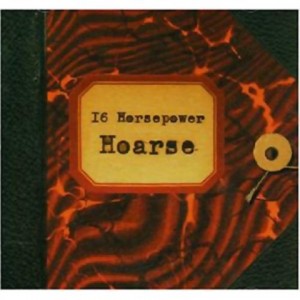16 Horsepower was an American alternative country music group based in Denver, Colorado. Their music often invoked religious imagery dealing with conflict, redemption, punishment, and guilt through David Eugene Edwards's lyrics and the heavy use of traditional bluegrass, gospel, and Appalachian instrumentation cross-bred with rock. For the bulk of its career, the band consisted of Edwards, Jean-Yves Tola, and Pascal Humbert, the latter two formerly of the French band Passion Fodder. After releasing four studio albums and touring extensively, the group broke up in 2005, citing "mostly political and spiritual" differences. The members remain active in the groups Woven Hand and Lilium.
We decided to stay in MN, but winters are getting tougher. The album cover is so appropriate when we speak to customers. Yes, we do become hoarse in trying to have customers convert from horse power to torque and speed.
I wonder if James Watt had similar problems. What happens when Naomi gets charged up? Does she get torqued or have speed concerns?
Servo Motors and Horsepower Rating
Servo Motors are not usually rated in Horsepower because:
- Servo Motors are usually used in incremental motion applications where the speed is frequently (and often rapidly) changing and delivered torque ranges from near nothing to brief periods of high peaks with an average of up to the continuous motor rating. These motors usually have a low inertia to power ratio.
- Motors that are typically rated in Horsepower are usually used in applications where the motor runs at a constant speed (and fixed input voltage) and delivers a slightly varying torque. These motors usually have a high inertia to power ratio.
Certainly, a Servo Motor CAN be rated in Horsepower but it has to be at a specific load point that is at the motor's continuous torque rating and a specific speed within the motor's speed range. The bus voltage of the driving control also has to be known.
Power is a value that cannot stand by itself while specing out a motor and in the physical realm (Power = Speed * Torque). When you are looking at getting a motor’s parameters defined with power, it is necessary to provide speed and/or torque values. You can calculate one of those three variables when provided with the other two. Keep in mind that BLDC (servo) motors have various modes of operation and the power of the motor in use could be lower, or even potentially higher, depending on the application. For example, two motors continuously rated at 1 HP, one motor run at 1000 RPM and the other 15000 RPM, would definitely have at a minimum different voltage constants and physical components constructing the motor.
Horsepower is a Torque - Speed product
If the 2 values are not "fixed", Horsepower becomes a slippery value. A handy conversion that is easy to remember is that 1 HP = 1,000,000 oz-in-RPM. Knowing this, a motor with a label rating of 1/2 HP at 1750 RPM (common AC motor) can deliver up to 285 oz-in (17.85 lb-in) (1.49 ft-lb) of torque. That would be a fully loaded rating. If the motor is running at less than rated load, it is not delivering 1/2 HP.
Similarly, a Servo Motor typically has a Continuous Torque rating, a Peak torque rating, a Ke, and a maximum operating speed. It may have a torque/speed curve based on a driver bus voltage and the continuous torque rating. A Horsepower rating for that motor could be the point on the curve where the speed-torque product is at its highest. However, if the motor is run slower or faster than this point, or the torque is lower than the continuous, the HP output will be lower.
Consequently, a typical servo application wherein the motor is expected to run at various speeds, directions, and torques, a Horsepower rating is essentially meaningless and the torque-speed curve is of greater value. However, in a power transmission application where the motor runs at a fixed speed and required torque is a specific maximum value, a Horsepower rating is of value.

